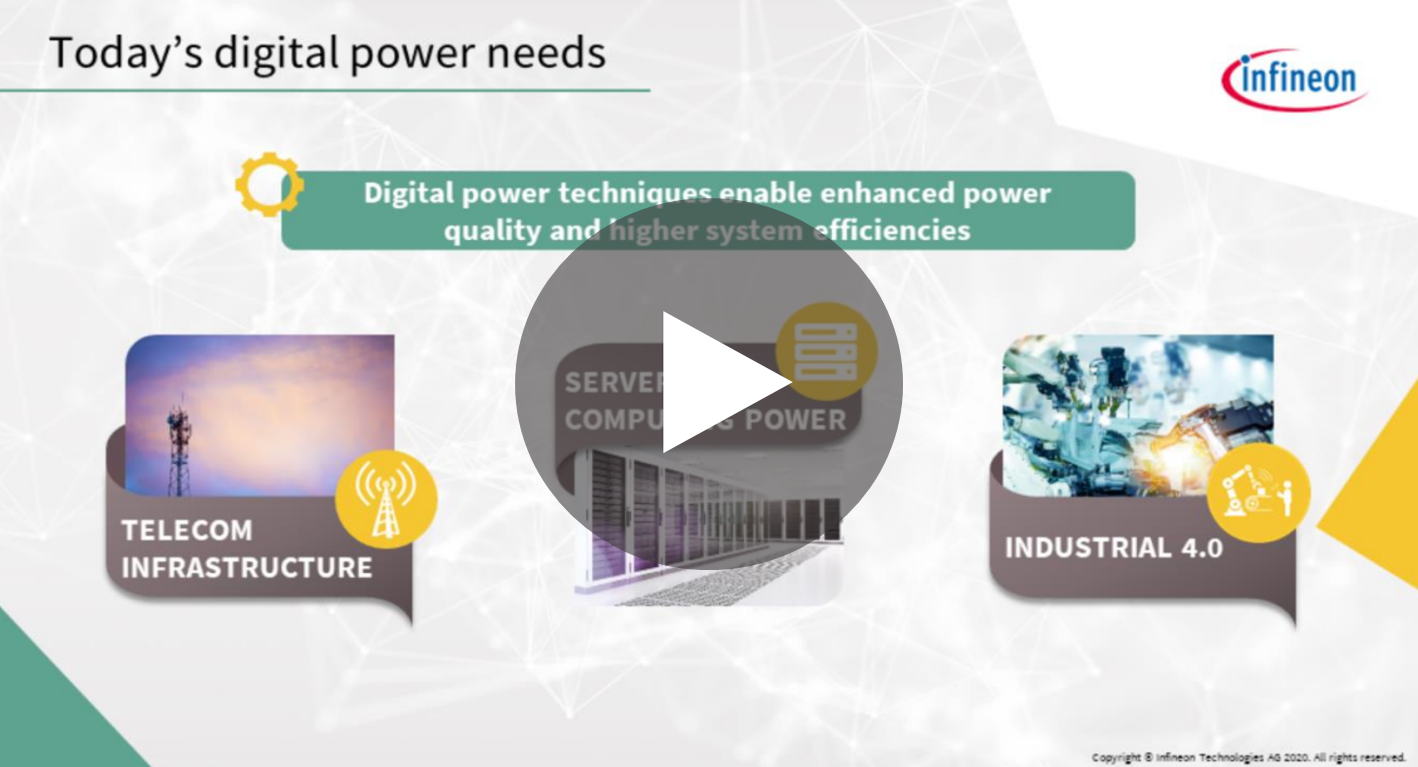Digital Power Controllers
XDP™ digital power controller with PMBus interface for isolated DC-DC power applications
The XDPP1100 product family expands Infineon’s XDP™ digital power controller portfolio. These highly integrated and fully programmable digital power controllers feature a combination of digital core and Arm® Cortex®-M0 based architecture. They offer optimized solutions for 48 V isolated DC-DC converters that require system-level communication such as PMBus interface, firmware-based differentiation, enhanced control, and housekeeping features with the microcontroller sub-system.
The XDPP1100 digital power supply controller family facilitates the development of smart power supplies for telecom infrastructures, server motherboards, industrial 4.0, and other high-end 48 V systems with pre-programmed superior digital control algorithms and unique features for flexibility. Infineon Technologies provides easy-to-use development tools to simplify the design-in with XDP™ products in a wide range of applications.
Infineon offers support tools, such as a complementary graphic user interface (GUI) that allows customers to configure and monitor key parameters. Additionally, developers have full control of their application and FW development process with commonly used Arm® based compilers.
The XDPP1100 digital power controllers come in two packages. With the XDPP1100 in 24-pin VQFN package Infineon offers the industry’s smallest digital power controller. With 12 PWM outputs, the XDPP1100-Q040 digital power controller supports various isolated and non-isolated topologies for a wide variety of DC-DC power applications.
For fifth generation (5G) wireless communication applications, high-performance PSUs are required to support higher power than the fourth generation (4G). For this reason, Infineon’s XDPP1100 digital power controllers support both step-down (buck) and step-up (boost) voltage conversion. A 97 percent peak can be achieved by using an extremely efficient, active Zero Voltage Switching (ZVS) circuit that transfers Qrr charge of the SR MOSFET to the output capacitor in a lossless way. The two-phase ZVS buck-boost converter enables a fast-dynamic response and high efficiency. Additionally, our digital power controllers are available with ZVS flyback converters for reduced switching losses, as well as ZVS forward converters.
Infineon’s XDP™ digital power controllers can be configured to support different DC-DC topologies including:
- Hard-switched full bridge and half bridge controller ICs
- Phase shifted full bridge
- Active clamp forward
- Interleaved FB, HB, and ACF
- Current-doubler
- Pre-buck or post-buck configuration
Phase shifted full bridge (PSFB) controllers are digital power controllers used for DC-DC conversions. PSFB controllers include a transformer, which provides isolation from the line voltage. Typical applications of a PSFB controller are to provide isolation for medium- to high-power telecom rectifiers, renewable energy systems, battery charging systems, and sever power supplies.
The primary function of this topology however, is to provide voltage translation across a variety of applications, particularly step-down conversions in high-voltage applications, such as telecom systems where a high voltage needs to be converted to an intermediate distribution voltage closer to 48 V.
PSFB converters generally function with zero voltage switching (ZVS), which ensures for more efficient conversions with minimal switching losses. With digital power solutions, such as high-performance ZVS phase shifted full bridge converters, designers can benefit from increased flexibility when it comes to both hardware and software applications.
Digital power controllers with active clamp forward converter topologies are highly suited to applications up to 500 W where good voltage handling and a high level of efficiency are desired.
Forward converters are very similar to buck switching converters, with the primary difference between the two topologies being that forward controllers offer isolation functions in addition to buck (step-down) and boost (step-up) conversions. By storing energy in the capacitator, active clamp forward converters can effectively utilize this energy to minimize losses and extend power conversion efficiency.
Zero Voltage Switching (ZVS) converters are highly efficient DC-DC topologies that allow for lossless power conversion. They are ideally suited to applications with a high input voltage and voltage drop and can function at any frequency. ZVS can be applied to most switching topologies, including zero voltage switching buck and boost converters. A zero voltage switching resonant converter switches when the voltage is at zero to facilitate zero power switching.
Switched capacitor power converters are DC-DC converters that utilize capacitors for voltage conversion and energy transfer. Unlike inductor-based switching converters, switched capacitor converters consist of multiple capacitors, which are charged during the switching cycle to successfully generate the power required by the load. The two most common types of resonant switched capacitor converters are the voltage inverter, which inverts the voltage charged in the first capacitor, and the voltage doubler, which doubles it.
As no inductors are required, switched capacitor converters generally allow for a simple application circuit of two or three capacitors and are compact in size, making them suitable for applications where a smaller component size is important, such as power supplies, electric traction devices and display panels, among others. Switched capacitor converters can be used with common DC-DC topologies like buck, boost and buck boost and offer high efficiency levels of up to 90%.




